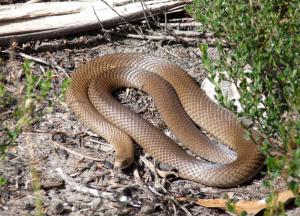Uhunt Mag Information
- Posted By : BRISTLE UP
- Posted On : Jun 25, 2019
- Views : 4672
- Category : PIG DOGGING » VET & HEALTH ARTICLES
- Description : "The Eastern Brown snake may not be the most venomous snake in Australia but records show it’s the most common snake to cause fatalities in Australia, most likely because it is a very common snake and it can be aggressive."
Overview
STEP 1
As soon as a bite occurs or is suspected, immobilise the patient. Humans should lie down as still as possible, dogs should be restrained as best as they can be without causing them to panic and struggle. If you get a look at the snake, note a general description or quickly take a photo without putting yourself in harm’s way, but do not waste time. Call 000 or for your dog call your local vet ASAP. Firmly apply an elasticised bandage over the bite area. Keep the bite wound below the heart if possible.
STEP 2
If the bite is on a limb, bandage it, even over clothing. For best results bandage the entire limb from just above the toes/fingers toward the top. If needed use several bandages. The bandages should be firm enough to reduce lymphatic movement but not restrict blood flow. Allow the bandage to be firm, keep the limb as still as possible using further thick bandages and a splint if possible. Await emergency services if possible or transport the patient to a vehicle without allowing too much movement, and get them to help. Do not remove the bandages and reassure them as much as possible whilst keeping them immobile.CORRECT BANDAGE USE

WHAT NOT TO DOG & WHY
- DO NOT wash the bite
Emergency personnel will need to do a venom detection test washing the wound will make it harder for this and will not help the patient.
- DO NOT apply a tourniquet
Completely cutting off the blood flow to the patient’s limb will cause the venom to pool and cause severe damage to the limb and often result in the amputation. Only in very selected situations should a tourniquet be used by a trained professional.
- DO NOT attempt to cut or suck the venom from the wound
This has proven to have no benefit to the patient as the venom has already entered the body, doing so will only risk more lives.
- DO NOT try to catch or kill the snake
Though it can be helpful to know the species of the snake as soon as possible risking more lives and wasting time is not going to help.MORE INFORMATION ABOUT SNAKE BITES & YOUR DOG
The worst time of year for snake bites is during the summer months, due to snake’s venom sacs being engorged and potent after months of hibernation. Australia is host to approximately 170 different species of snakes, with around 100 of those being venomous. A popular myth is that a snake’s first bite is a warning “dry” bite, where no venom is injected; this is simply not true. Limbs and noses are the most common place that a dog will be bitten. In extreme cases CPR may need to be conducted during the trip to the vet, commence chest compressions at 60-100 beats per minute for dogs while the animal is lying right side down (the heart is located in the left side of the chest cavity). Treatment will vary depending on the individual circumstances; typical treatment is an IV drip with fluids and antivenin, and further therapy such as anti-seizure medication, pain killers, oxygen etc will be given as needed.
Antivenin neutralizes the venom in the dog’s body and will not make a dog immune to venom from future bites. The average recovery time at the vet for dogs that survive is about 48 hours. Being trained in first aid, hunting your dogs close, checking over them during and after hunts, and training them to leave snakes alone can all be beneficial in preventing bites and treating them quickly. Venom from different species of snakes affects different body systems, so symptoms can present variably. Some common signs that a snake bite has occurred may include; Disorientation, sudden weakness followed by collapse, tremors/convulsing, vomiting, difficulty swallowing, abnormal heart/respiratory rates, dilated pupils not responsive to light and blood in the urine.
EASTERN BROWN SNAKE
(Most likely snake to kill you in Australia)
The Eastern Brown snake may not be the most venomous snake in Australia but records show it’s the most common snake to cause fatalities in Australia, most likely because it is a very common snake and it can be aggressive. Adult Eastern Brown snakes are highly variable in color. Whilst usually a uniform shade of brown, they can have various patterns including speckles and bands, and range from a very pale fawn color through to black, including orange, silver, yellow and grey. Juveniles can be banded and have a black head, with a lighter band behind, a black nape, and numerous red-brown spots on the belly. So make sure you can Identify a brown snake as its the most likely one to lead to death.
(BELOW - Eastern Brown Snake)
By Bella Jaye
